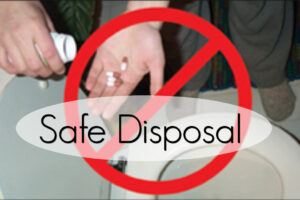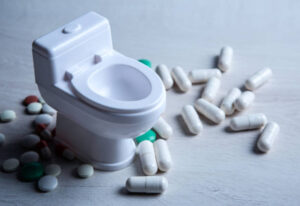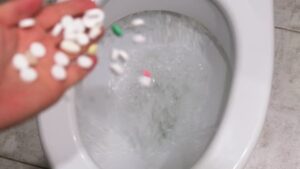When it comes to disposing of opioid medication, myths abound. Many believe that _”the best way to dispose of opioid medication is to crush the pills and flush them down the toilet.
But is this method safe or even recommended? This article shines a light on the risks associated with flushing opioid medications and offers insight and practical advice on safer disposal methods. Prepare to debunk some myths and enhance your understanding of proper medication disposal.
The Reality Behind Flushing Opioid Medication
In a world where the disposal of medication, particularly opioids, poses a growing concern, myths can often lead to harmful practices.
 Among these, one prevalent belief stands out: _”the best way to dispose of opioid medication is to crush the pills and flush them down the toilet.”_ This advice, albeit widespread, is far from the truth. The reality is, such practices not only fail to adhere to safety guidelines but also pose significant risks to both human health and the environment.
Among these, one prevalent belief stands out: _”the best way to dispose of opioid medication is to crush the pills and flush them down the toilet.”_ This advice, albeit widespread, is far from the truth. The reality is, such practices not only fail to adhere to safety guidelines but also pose significant risks to both human health and the environment.
As we navigate through the facts, it becomes clear that proper disposal methods are essential. Understanding the actual implications of flushing medication helps us recognize the importance of seeking out and following safer alternatives. Through debunking myths, our aim is to empower you with knowledge for responsible medication disposal, steering clear of hazards associated with improper methods.
The Surprising Risks of Crushing Pills and Flushing Them Down the Toilet
Dispelling the myth that _”the best way to dispose of opioid medication is to crush the pills and flush them down the toilet,”_ is crucial.
This practice not only contravenes safety guidelines but introduces a host of risks. When opioids are flushed, they enter the water system, potentially contaminating our drinking water and harming aquatic life. Moreover, crushing pills can lead to accidental exposure to the drug's active ingredients, posing a significant risk to individuals, especially children and pets, who may come into contact with it.
The potential for misuse or accidental ingestion of these potent substances increases, underscoring the importance of adhering to recommended disposal methods. Understanding these risks is the first step toward protecting our health and the environment from unintended consequences.
Understanding the Environmental Impact of Flushing Medication
The act of flushing medication down the toilet has far-reaching consequences for our environment.

- Pharmaceuticals, including opioids, that enter our water systems can significantly impact aquatic life.
- Studies have shown that exposure to even trace amounts of these medications can alter the behavior, reproduction, and growth of fish and other aquatic organisms.
The broader ecological balance is at risk, as these effects can cascade through the food web. Additionally, water treatment facilities are not fully equipped to remove all pharmaceutical compounds, leading to potential contamination of drinking water sources. This underscores the necessity of seeking alternative disposal methods that safeguard our planet's health and ensure the well-being of future generations.
Alternatives to Flushing: Safe Ways to Dispose of Opioids
Acknowledging the risks associated with flushing opioids prompts the question: What are the safer alternatives? Fortunately, there are several. One effective method is utilizing drug take-back programs offered by pharmacies, clinics, and local governments.
These programs ensure that medications are disposed of securely and responsibly. If a take-back program is not accessible, the Food and Drug Administration recommends mixing the medication (without crushing) with an unpalatable substance like dirt, cat litter, or used coffee grounds.
Then, place the mixture in a sealed plastic bag and dispose of it in your household trash. Additionally, removing any personal information from prescription labels before disposal protects your privacy. These methods help minimize environmental impact and prevent misuse of opioids.
How to Properly Dispose of Pill Bottles and Packaging
Disposing of the medication itself is only part of the equation; proper disposal of pill bottles and packaging is equally critical.
 To begin with, always remove or blackout personal information from prescription bottles and packaging to protect your privacy. Most plastic medication bottles can be recycled after they have been cleaned and labels have been removed.
To begin with, always remove or blackout personal information from prescription bottles and packaging to protect your privacy. Most plastic medication bottles can be recycled after they have been cleaned and labels have been removed.
However, recycling guidelines vary by location, so it's essential to check with your local recycling program. For blister packs and other non-recyclable components, disposing of them in the household trash is usually acceptable. Remember, the goal is to ensure these materials don't pose an environmental hazard or become a source of personal information theft.
Debunking Common Myths: Flushing Opioids is Not the Best Method
In conclusion, the commonly held belief that _”the best way to dispose of opioid medication is to crush the pills and flush them down the toilet”_ is a myth that needs urgent debunking.
Not only does this practice pose significant risks to our health and the environment, but it also ignores a variety of safer, more responsible disposal methods available. By understanding the actual implications of our disposal habits and opting for alternatives such as take-back programs, we can prevent the misuse of opioids and protect our ecosystems. As responsible individuals, it's our duty to inform ourselves and make choices that contribute to the well-being of our communities and the planet at large.
